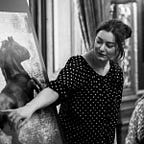Interview: Aimée Rolin Hoover
Horses are always in the present, they don’t travel back and forth through time, past to present, like we humans do. They are not distracted by everyday things. The things that keep us from reaching our goals, doing our job or just being happy. Aimée’s Flymask series are a beautiful metaphor for these daily distractions and when looking at the Flymask paintings you see why. With the flymasks on, there are no big eyes or faces to make a connections with, no distractions.
I interviewed American wild life artist Aimée Rolin Hoover (b. 1969) for Dutch equestrian magazine Bit and asked her five questions to get to know the person behind the artist. The interview was published august 2019.
At what age did you become interested in art?
“My very earliest memory from when I was about three years old is drawing on the floor near a bright window. So I don’t remember not being interested in art — it became a part of what I did so early in life. But I’m really lucky that my parents supported that early interest of mine. I remember when I was nine years old my mom gathered up all my drawings, scooped me up from school, and drove us to a local community college. She grabbed my hand and we walked right into an art class in progress. I didn’t even know what was going on and remember feeling very embarrassed as everyone started to look at my doodles. But she had noticed how obsessed I was becoming with drawing, and wanted me to have an after school art tutor once a week. She ended up hiring an college art student on the spot.”
What makes the horse an inspirational subject for you?
“On a sheerly aesthetic level, their elegant, graceful lines, and their powerful bodies are enough to make them fantastic subjects to paint. But it’s their special relationship with us humans that keep me coming back to them. They evoke a sense of freedom, desire and will, but they’re willing to offer us humans the illusion of control order to work together. They also act like a giant 1000 pound mirror as far as what is going on internally with us. It’s tough to fool a horse. Just like with kids and dogs, you can’t trick them into liking you!”
How did you develop your work over the years?
“It took me a very long time to learn this, but I think developing as an artist comes down to just one thing: practice. Being a painter, for me, is a life long pursuit. There’s no visible end point and no sense of being truly “finished.” It’s just a lifetime of practice, trying to narrow the gap between what I envision in my head and what actually ends up on the canvas. Knowing that I’ll never really get there is both frustrating and liberating at the same time. I have days in the studio of enormous satisfaction, then utter boredom, then frustration, then eventually, when I’m lucky, inspiration. Knowing it’s a process and not an end game means that even when I’m in a period of deep frustration, I know that satisfaction or (ideally) inspiration is just around the corner. So it’s a matter of showing up, doing the work, and trusting that if I can just get myself to the studio every day, my work will evolve.”
Tell us about your best horse moment or memory.
“About eight years ago, I was invited to do some horse whispering with client in Arizona. I didn’t know what “horse whispering” really was at the time. All I knew is that I adored this new client and it involved horses and that was enough for me. The goal of the experience was to be able to “join up” with the horse so that it trusts you enough to follow you completely on its own. One of the ways you do this is to adjust your energy so that you feel calm, confident, and centered. So I went through a few minutes of instruction by the Equus coach, then they let a horse into the ring with me. In less than 30 mins, I was running around giggling, and this horse — who I had just met — was chasing me like we were playing tag. It’s muzzle practically on my neck. I was zig zagging around laughing out of sheer joy and the more I laughed, the more the horse seemed to be having fun. I had ridden horses before but I never had an experience like that with us both on the ground. It was truly magical.”
Who are your sources of inspiration, people you admire or look up to?
“I feel more and more pulled towards incorporating abstraction in my own work. So I’m currently inspired by abstract painters, or abstract figurative painters. One of my favorite artists right now is Alex Kanevsky. While he is not primarily an equine artist, I saw a horse painting he did recently and I was just blown away by the work.”
JTH
Aimée’s interview was published in Bit magazine, august 2019.
For more on Aimée’s work, click here.
Stay connected
Facebook Instagram Pinterest Twitter
Copyright © 2019 by Joyce Ter Horst/Paard Verzameld. All rights reserved.
Paard Verzameld platform for equine art ®, Paard Verzameld Collective ®
are registered trademarks. All rights reserved, 2019.
No part of this publication may be reproduced, distributed, or transmitted in any form or by any means, including photocopying, recording, or other electronic or mechanical methods, without the prior written permission of the writer.
